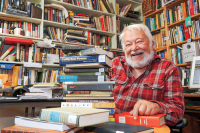The life-long legacy of a few brushmarks
By Lew Garnett
Without his ever knowing it, Blaine Richardson was one of my heroes.
It was a recent breezy Saturday at our karate school, where over the past few years I’d fought a sharp contest between my 50-year-old body and my 20-year-old expectations.
But we’d just expanded our facility and about 10 of us were repainting the entire studio. I sat at the base of a wall, scooting the seat of my raggedest jeans along the concrete floor while our rubber training mats were outside being washed. And I was employing my brush just like Blaine had taught me so many years ago.
Blaine was a painter. As far as I knew, that’s the only living he’d ever made around my little home town. Richardson was a common name there — not as widespread as Blevins, but enough to consume half a column in the phone book.
Richardsons came in all varieties: some were bigshots, wealthy founders of this and that; others were not. I played summer baseball with some, but didn’t have any as close friends.
Related Items
One was an eye, ear, nose and throat doctor. I’m sure he was a nice enough fellow, but at least from a kid’s perspective, his office demeanor personified the detached scientist: coldly analytical, emotionless, a little scary. I could feel his eyes passing through me as if I were nothing but wires and hinges and plumbing.
My mother would take me to him for the upper-respiratory whoppers that plagued my winters. The worst part was when he’d stick that stainless steel suction thing up my nose and — with the equivalent of ice picks in my ears — pull what felt like gallons of horrid, infected mucus from my sinuses.
Incidentally, the suction torture became unnecessary after my father quit smoking, which made the air in our house less toxic with the windows down.
Dr. Richardson was helpful, but Blaine Richardson was instructive.
One summer day when I was about 6, he came to paint our bathroom, but unlike so many adults doing adult things, Blaine let me hang around. I was probably in the way a little, yet he didn’t seem to mind, or at least said nothing about it. In fact, I don’t remember him saying much at all.
I do remember standing beside his sun-dulled work truck in our driveway, quietly observing his graying head and weathered neck as he knelt over a freshly opened gallon of oil-based paint. With his profession’s version of a tongue depressor, he’d stir firmly and slowly, first one way, then the other, occasionally lifting the stick at an angle to watch the paint run off, much like my mother checking her stew base as it cooked down. Then with callused hands he’d dribble in a bit of turpentine and continue stirring and checking until the mixture was creamy, smooth-sliding and luscious.
There was no dinging timer or rattling pressure-pot weight to signal done. He didn’t even change expressions. He just stopped stirring, picked up the can by its wire handle and, with me puppy-dogging along behind, headed through our basement garage and up the wooden steps.
In the confines of our tiny bathroom — before paint fumes were blamed for brain damage — I collected a solid noseful of the delicious odor. It smelled a bit like gasoline but not as filmy, had body and seemed almost edible.
But here’s the pinnacle image I’ve kept all these years, the motion picture of my teacher teaching: Blaine was sitting thin-legged and bony on the lid of our commode, his coveralls sagging like one of Dad’s shirts on me.
Time dissolved.
First, he pulled a tab-stringed pouch from his breast pocket and casually rolled a cigarette. His eyes calmly surveyed an unpainted corner.
Dipping a wide, sharp-bristled brush about halfway into the grass-green liquid and scraping off what he somehow knew was too much, he placed it expertly into the corner and gently squiggled the bristles from side to side, continuing the motion as he brushed gently outward. Then he turned the brush over and did it again, adding more color whether the old paint showed through or not. Finally, with that same deftness, he tenderly smoothed his work with a single, unsquiggled stroke, leaving only faint, fine brushmarks atop his work.
Slathering was simply not in his repertoire. With unhurried, careful attention, he greened our drab wall four inches at a time, transforming it slick, shiny, smelly and wonderful.
His profession — painting things — was relatively simple. In like manner, Blaine wasn’t fancy, flamboyant or self-promoting. But inside those baggy, white coveralls lived a 1950s craftsman, if not an artisan.
In today’s frenetic business world of maximum volume at minimum cost, spurred by unfettered international competition and an overworked, disposable labor force, Blaine would never have survived, his thoroughgoing handiwork relegated with him to the human scrap heap.
And had I not been volunteering my time at the karate studio, I’d have been fired halfway down the wall. Time had no meaning as, in my best Blaine Richardson imitation (without the cigarette), I dipped, rim-cleared, squiggled and smoothed paint from the edge of the baseboard up onto the sheetrock.
Twice I was offered a straight-edged painting tool, but declined without explanation. To use it would have impersonalized my work, made it production-line industrial and left a microscopic unpainted line above the baseboard. But more importantly, it would have sabotaged my unspoken, near-reverent testimony to a mentor long deceased.
Other karate students trimming other walls with straight-edges had long since finished when I finally propped my brush on the can lid and looked back to admire Blaine’s work.
The lethargic odor of today’s less toxic, water-based paint taxed my memory of our oil-fragrant bathroom, but for a timeless slice of a day in my mid-50s, I’d younged myself enough to sit again patiently and quietly beside my hero: to puzzle how he kept that sagging cigarette in his lips, to feel gently intimidated by his work-hardened countenance, and to follow his every move, his every squiggle — those faint brushmarks indelible on my life.
(Lew Garnett keeps a cabin in Maggie Valley from where he writes.)









